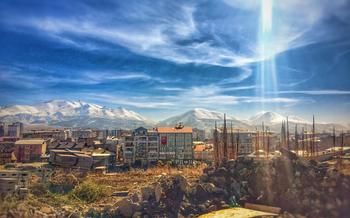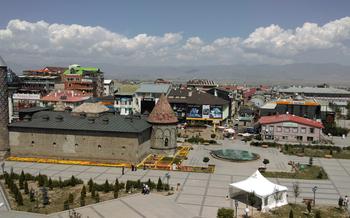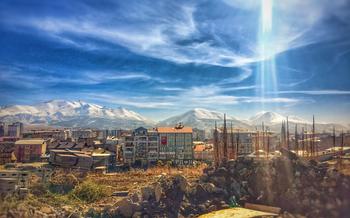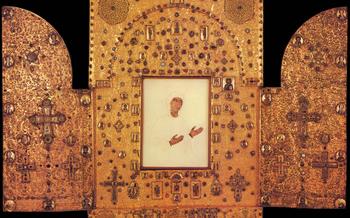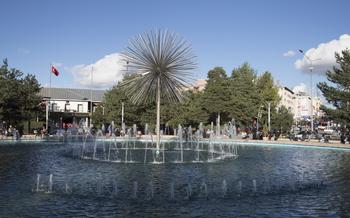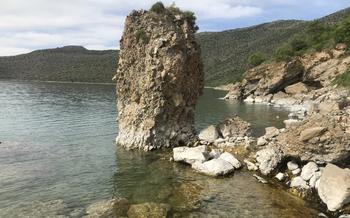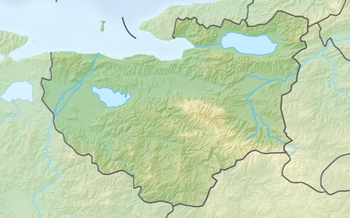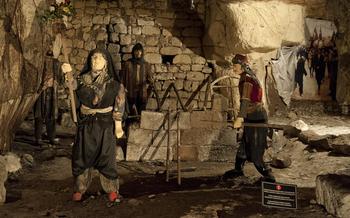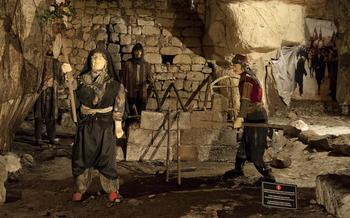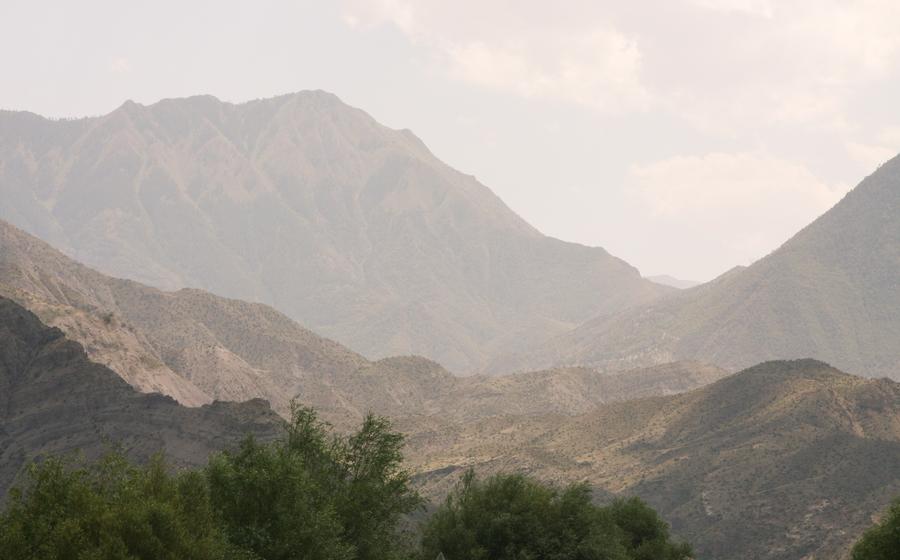
Karaçoban Meadows
- Historical Background
- Geographic Setting
- Flora and Fauna
- Cultural Significance
- Economic Importance
- Historical Sites
- Outdoor Activities
- Visitor Facilities
- Festivals and Events
- Local Cuisine
- Transportation
- Getting to the Karaçoban Meadows
- Photography Opportunities
- Accommodation
- Shopping
- Insider Tip
Historical Background
The Karaçoban Meadows, nestled amidst the majestic mountains of Eastern Turkey, hold a rich tapestry of history and cultural significance. Throughout the centuries, nomadic tribes have roamed these fertile lands, leaving their mark on the landscape and the traditions of the region. The meadows have served as a meeting point for traders, travelers, and pilgrims, who converged to exchange goods, share stories, and celebrate their shared heritage.
The name Karaçoban, meaning "black shepherd" in Turkish, is believed to originate from the nomadic Karaçoban tribe, who have long been associated with these meadows. The tribe's mastery in animal husbandry and their deep connection to the land have shaped the unique cultural identity of the region. Over time, the Karaçoban Meadows have become an integral part of Turkish culture, symbolizing the enduring spirit of nomadic traditions and the resilience of the human connection to nature.
Geographic Setting
The Karaçoban Meadows are located in the Erzurum Province of eastern Turkey, nestled amidst the majestic peaks of the Erzurum Mountains. This breathtaking region unfolds at an elevation of approximately 2,200 meters above sea level, offering an unparalleled panorama of natural beauty. The meadows stretch across a vast expanse, encompassing lush green pastures, crystal-clear streams, and vibrant wildflowers that paint a vibrant tapestry of colors.
The geographic setting of the Karaçoban Meadows is a harmonious blend of rugged landscapes and serene vistas. Towering mountain ranges encircle the meadows, their snow-capped summits piercing the azure sky. Verdant forests cloak the hillsides, providing a sanctuary for a diverse array of wildlife. The meadows themselves are a tapestry of verdant grasslands, dotted with wildflowers and punctuated by meandering streams. The air is pure and invigorating, filled with the sweet fragrance of mountain herbs and the melodious chirping of birds.
The climate of the Karaçoban Meadows is characterized by warm summers and cold winters. July and August are the warmest months, with average temperatures ranging from 15 to 25 degrees Celsius. January and February are the coldest months, with average temperatures dropping below freezing. The annual precipitation is moderate, with most of the rainfall occurring in the spring and autumn.
The Karaçoban Meadows are a true gem of Turkey's natural heritage, offering a sanctuary for wildlife, a haven for relaxation, and a living testament to the country's rich cultural traditions.
Flora and Fauna
The Karaçoban Meadows are home to a wide variety of plant and animal species, making it a biodiversity hotspot. The meadows are carpeted with colorful wildflowers, including daisies, poppies, and lilies, creating a breathtaking natural tapestry. The surrounding mountains and forests provide a habitat for numerous animal species, including bears, wolves, foxes, and deer. Birdwatchers can delight in the diverse birdlife, with eagles, hawks, and vultures soaring overhead, while smaller species such as finches, larks, and buntings flit among the flowers.
Among the unique flora and fauna found in the meadows are several endemic species, found nowhere else in the world. The Karaçoban daisy, with its vibrant yellow petals, is a symbol of the region and a popular subject for photographers. The meadows are also home to the endangered Karaçoban frog, a small, brightly colored amphibian that relies on the unique ecosystem of the meadows for its survival. Conservation efforts are underway to protect these and other endemic species and ensure the delicate balance of the ecosystem.
Cultural Significance
The Karaçoban Meadows have played a vital role in Turkish culture for centuries. The nomadic Karaçoban people have called these meadows home, relying on them for sustenance and a way of life. Their traditional practices, such as sheepherding and weaving, are deeply intertwined with the meadows' natural beauty and resources.
The Karaçoban Festival, held annually in the meadows, is a vibrant celebration of this unique culture. Thousands of visitors gather to witness sheep shearing competitions, traditional music and dance performances, and other festivities that showcase the rich heritage of the region.
The meadows are also deeply embedded in Turkish folklore and mythology. Legends and tales abound, passed down through generations, that speak of mystical creatures, hidden treasures, and ancient battles fought on these lands. The meadows' natural beauty and cultural significance have made them a source of inspiration for artists, writers, and poets throughout history.
Economic Importance
The Karaçoban Meadows play a vital economic role, with livestock grazing and agriculture being the primary sources of income for the local communities. The vast grasslands provide ideal grazing conditions for sheep, cattle, and horses, supporting a thriving livestock industry. Farmers also cultivate crops such as wheat, barley, and potatoes in the fertile soil of the meadows, contributing to the region's agricultural output.
In recent years, tourism has emerged as a significant economic driver for the Karaçoban Meadows. The region's natural beauty, cultural heritage, and outdoor activities attract a growing number of visitors, generating revenue for local businesses and creating employment opportunities. Visitors to the meadows can enjoy a variety of recreational activities, including hiking, camping, wildlife watching, and bird watching.
The tourism industry in the Karaçoban Meadows is still in its early stages of development, but it has the potential to make a substantial contribution to the local economy. With its stunning landscapes, rich cultural heritage, and diverse outdoor activities, the meadows offer a unique and unforgettable experience for visitors from around the world.
Historical Sites
The Karaçoban Meadows are home to a wealth of historical sites that offer a glimpse into the region's rich past. Among the most notable are the ruins of ancient settlements, dating back to the Bronze Age and beyond. These settlements provide valuable insights into the lives and cultures of the people who once inhabited this region.
Mausoleums and tombs are also scattered throughout the meadows, serving as reminders of the area's long and storied history. These structures often feature intricate carvings and inscriptions that shed light on the lives and achievements of the individuals buried within.
Finally, petroglyphs and rock art can be found in various locations within the meadows. These ancient carvings depict scenes from everyday life, hunting, and religious rituals, providing a unique glimpse into the beliefs and practices of the region's earliest inhabitants.
Outdoor Activities
The Karaçoban Meadows offer a range of outdoor activities for visitors to enjoy. Hikers and trekkers can explore the vast network of trails that wind through the meadows, offering breathtaking views of the surrounding mountains and valleys. Camping and picnicking spots are scattered throughout the area, providing opportunities for visitors to immerse themselves in the natural beauty of the region. Wildlife enthusiasts can indulge in birdwatching and observe the diverse bird species that call the meadows home. The crystal-clear streams and rivers that run through the meadows are perfect for fishing, while the lush green pastures provide excellent grazing for horses, making horseback riding a popular activity in the area. Visitors can also embark on jeep safaris to explore the more remote corners of the meadows and encounter the region's unique flora and fauna.
Visitor Facilities
The Karaçoban Meadows offer a range of visitor facilities to ensure a comfortable and enjoyable experience. Accommodation options cater to different budgets and preferences, from cozy hotels and guesthouses to traditional yurts that provide a unique cultural immersion. These accommodations offer comfortable lodgings, often with stunning views of the meadows and surrounding mountains.
Restaurants and cafes are scattered throughout the area, serving a variety of local and international cuisines. Visitors can savor delicious Turkish dishes made with fresh, locally sourced ingredients, while enjoying the breathtaking views of the meadows.
Visitor centers and information kiosks provide valuable information about the history, culture, and natural attractions of the Karaçoban Meadows. These centers offer maps, brochures, and guided tours, helping visitors plan their itinerary and make the most of their time in the region.
Festivals and Events
The Karaçoban Meadows come alive with festivals and events throughout the year, offering a glimpse into the vibrant culture of the region. The most notable event is the annual Karaçoban Festival, held in the summer months. This lively festival showcases the rich traditions of the Karaçoban people, with colorful parades, traditional music and dance performances, and equestrian displays. Visitors can also witness sheep shearing competitions, where skilled shepherds demonstrate their expertise in shearing sheep with precision and speed. Other notable events include the Erzurum Kervansaray Festival, featuring historical reenactments and performances, and the Erzurum International Winter Sports Festival, attracting winter sports enthusiasts from around the world. These festivals provide a unique opportunity to immerse oneself in the local culture and experience the warm hospitality of the Karaçoban people.
Local Cuisine
The Karaçoban Meadows region offers a unique and delectable culinary experience, showcasing the flavors and traditions of the nomadic Karaçoban people. Visitors can indulge in a variety of regional dishes and delicacies, many of which are made with fresh, local ingredients.
One of the must-try dishes is "Karaçoban Köftesi", a succulent lamb patty that is grilled to perfection and served with a tangy tomato sauce and grilled vegetables. Another popular dish is "Çiğ börek", a crispy pastry filled with a mixture of herbs, cheese, and minced meat.
For those with a sweet tooth, "Karaçoban Helvası" is a delightful dessert made with flour, sugar, and butter, often infused with flavors such as vanilla or pistachio. "Ayran Aşı", a refreshing yogurt soup, is another local specialty, often served with crunchy croutons and fresh herbs.
To fully immerse oneself in the culinary culture of the region, visitors can take part in cooking classes or workshops offered by local families or restaurants. These experiences provide a hands-on opportunity to learn traditional recipes and techniques, creating lasting memories and a deeper appreciation for the region's rich gastronomic heritage.
Transportation
Getting to the Karaçoban Meadows
Reaching the Karaçoban Meadows is a journey that combines the convenience of modern transportation with the charm of traditional nomadic routes. The meadows are situated in a remote region of eastern Turkey, approximately 150 kilometers from the city of Erzurum. While public transportation is limited, there are several options for visitors to access this enchanting destination.
For those seeking a comfortable and direct journey, the best option is to rent a car. The drive from Erzurum to the meadows takes around two hours, passing through picturesque landscapes and traditional villages. Visitors can rent a car from various agencies in Erzurum, ensuring a hassle-free and flexible travel experience.
For those who prefer a more immersive and authentic experience, hiring a tour guide is an excellent choice. Local tour operators in Erzurum offer guided tours to the Karaçoban Meadows, providing valuable insights into the region's history, culture, and natural wonders. Guided tours typically include transportation, meals, and accommodation, allowing visitors to fully immerse themselves in the nomadic way of life.
Public transportation options to the Karaçoban Meadows are limited but not entirely unavailable. Visitors can take a bus from Erzurum to the town of Karaçoban, located approximately 30 kilometers from the meadows. From Karaçoban, visitors can either hire a taxi or arrange for a local transfer to reach the meadows. This option offers a more economical alternative for budget-conscious travelers.
No matter the chosen mode of transportation, the journey to the Karaçoban Meadows is an adventure in itself, offering glimpses into the diverse landscapes and rich cultural heritage of eastern Turkey.
Photography Opportunities
With its stunning landscapes, rich flora and fauna, and captivating cultural heritage, the Karaçoban Meadows offer a wealth of opportunities for photographers of all levels. The meadows are a natural paradise for landscape photography, with rolling green hills, vibrant wildflowers, and snow-capped mountains providing a backdrop for breathtaking shots. Photographers can capture the beauty of the meadows in all seasons, from the vibrant colors of spring to the golden hues of autumn.
Wildlife enthusiasts will find plenty of subjects to photograph, including grazing sheep, soaring eagles, and marmots scurrying among the rocks. The meadows are also home to a variety of reptiles, amphibians, and insects, providing macro photographers with ample opportunities to capture close-up shots of these fascinating creatures.
In addition to the natural beauty of the meadows, photographers can also find inspiration in the cultural heritage of the Karaçoban people. Traditional yurts, stone houses, and ancient ruins offer a glimpse into the history and traditions of this nomadic community. Visitors can also photograph the colorful festivals and events that take place in the meadows throughout the year, capturing the vibrant energy and spirit of the Karaçoban people.
For those interested in capturing the essence of the Karaçoban Meadows, the best time to visit is during the spring or summer months, when the weather is warm and the meadows are in full bloom. Photographers should come prepared with a variety of lenses, from wide-angle to telephoto, to capture the diverse range of subjects found in the meadows. A tripod is also recommended for capturing sharp images of the landscape and wildlife.
Accommodation
The Karaçoban Meadows offer a range of accommodation options, catering to different budgets and preferences. Whether you seek a comfortable hotel room, a cozy guesthouse, or an authentic experience in a traditional yurt, you'll find suitable options in the area.
For those seeking a luxurious stay, several hotels and resorts offer modern amenities and stunning views of the meadows. These establishments often feature spacious rooms, private balconies, and access to swimming pools and spas.
If you prefer a more intimate and local experience, guesthouses and bed and breakfasts provide a warm and welcoming atmosphere. These smaller establishments often offer personalized service and the opportunity to interact with local families.
For a truly unique and immersive experience, consider staying in a traditional yurt. These circular tents made of felt and wool offer a glimpse into the nomadic lifestyle of the Karaçoban people. Yurts are typically furnished with comfortable beds, carpets, and traditional furnishings, providing a comfortable and authentic stay.
Camping enthusiasts will find designated campsites within the meadows, offering basic facilities such as restrooms, showers, and picnic areas. These campsites provide an excellent opportunity to connect with nature and enjoy the tranquility of the meadows under the starry sky.
Shopping
If you're looking for a unique souvenir to remember your trip to the Karaçoban Meadows, be sure to visit the local markets and shops. Here, you can find a variety of handcrafted items, including traditional textiles, carpets, and pottery. You can also purchase fresh produce and agricultural products, such as honey, cheese, and dried fruits.
The Karaçoban Meadows are home to a number of talented artisans who create beautiful and intricate handicrafts using traditional techniques. Many of these artisans sell their work at the local markets and shops, making it a great place to find one-of-a-kind souvenirs.
When shopping for handicrafts in the Karaçoban Meadows, it's important to be respectful of the local culture. Be sure to ask permission before taking photos of artisans at work, and always negotiate prices in a fair and respectful manner.
Here are some tips for shopping in the Karaçoban Meadows:
- Visit the local markets and shops to find a variety of handcrafted items and agricultural products.
- Be sure to ask permission before taking photos of artisans at work.
- Always negotiate prices in a fair and respectful manner.
- Support the local economy by purchasing products from local artisans and farmers.
Insider Tip
To make the most of your visit to the Karaçoban Meadows, plan your trip during the spring or summer months. The weather is at its best during this time, with warm, sunny days and cool nights. The meadows come alive with a vibrant array of wildflowers, transforming the landscape into a colorful tapestry. You'll have the opportunity to witness the meadows in their full glory and capture stunning photographs of the blooming flowers against the backdrop of the majestic mountains. Spring and summer are also the best time to spot the diverse wildlife that call the meadows home, including birds, butterflies, and other creatures. Embrace the opportunity to immerse yourself in the beauty and tranquility of the Karaçoban Meadows during these ideal months.
